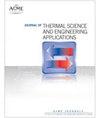Numerical Analysis of the Thermal-hydraulic Performance of Supercritical LNG in Airfoil Fin PCHEs
IF 1.4
4区 工程技术
Q3 ENGINEERING, MECHANICAL
引用次数: 0
Abstract
Abstract As a novel, compact, and efficient plate-fin heat exchanger, the Printed Circuit Heat Exchanger (PCHE) is a prospective candidate for liquefied natural gas (LNG) vaporization at low-temperature and high pressure. Generally, the airfoil fin PCHE has better thermal-hydraulic performance than the zigzag channel PCHE. In this study, the thermal-hydraulic performance of supercritical LNG in PCHEs with different airfoil fin types and arrangements is investigated by numerical simulations. First, the effects of six different airfoil fin types, NACA0010, NACA0020, NACA0025, NACA0030, NACA 0040, and NACA 0050, on the thermal-hydraulic performances were studied. The results show that NACA0025 has the best comprehensive heat transfer performance. Then, the effects of staggered, vertical, and horizontal pitch of the airfoil fin arrangement on thermal-hydraulic performance were investigated. The results show that the optimal values of the dimensionless number for staggered and vertical arrangements are 1 and 4, respectively. The comprehensive performance does not change much when the dimensionless horizontal pitch number exceeds 3.0. Finally, the thermal-hydraulic performance of uniformly distributed, three front sparse and rear dense, and three front dense and rear sparse distributed airfoil fins was investigated. The results show that the front dense and rear sparse airfoil fins enhance and the front sparse and rear dense airfoil fins reduce the comprehensive performance compared to the uniform arrangement. The results show that a denser arrangement of airfoil fins near the quasi-critical point can improve the comprehensive performance while keeping the number of airfoil fins constant.超临界LNG在翼型翅片pch中的热工性能数值分析
作为一种新颖、紧凑、高效的板翅式换热器,印刷电路换热器(PCHE)是液化天然气(LNG)低温高压汽化的理想选择。一般情况下,翼型翅片PCHE的热工性能优于锯齿形通道PCHE。本文采用数值模拟的方法,研究了超临界LNG在不同翼型和布置的pch中的热工性能。首先,研究了NACA0010、NACA0020、NACA0025、NACA0030、NACA 0040和NACA 0050 6种不同翼型对飞机热液性能的影响。结果表明,NACA0025具有最佳的综合传热性能。然后,研究了交错、垂直和水平桨距对翼型热工性能的影响。结果表明,交错排列和垂直排列时,无量纲数的最优值分别为1和4。当无量纲水平螺距数超过3.0时,综合性能变化不大。最后,对均匀分布、三前稀后密、三前密后稀分布翼型的热液性能进行了研究。结果表明:与均匀布置相比,前密后密翼型提高了综合性能,前密后密翼型降低了综合性能;结果表明,在保持翼型数量不变的情况下,在准临界点附近密集布置翼型可以提高综合性能。
本文章由计算机程序翻译,如有差异,请以英文原文为准。
求助全文
约1分钟内获得全文
求助全文
来源期刊

Journal of Thermal Science and Engineering Applications
THERMODYNAMICSENGINEERING, MECHANICAL -ENGINEERING, MECHANICAL
CiteScore
3.60
自引率
9.50%
发文量
120
期刊介绍:
Applications in: Aerospace systems; Gas turbines; Biotechnology; Defense systems; Electronic and photonic equipment; Energy systems; Manufacturing; Refrigeration and air conditioning; Homeland security systems; Micro- and nanoscale devices; Petrochemical processing; Medical systems; Energy efficiency; Sustainability; Solar systems; Combustion systems
 求助内容:
求助内容: 应助结果提醒方式:
应助结果提醒方式:


